Numerous Reports Confirm Stark Racial Disparities in Portland’s Criminal Justice System
Last week the Portland Mercury published an article about attempts by Multnomah County, Oregon officials to censor data revealing stark racial disparities in Portland’s criminal justice system. Multnomah County research analyst Amanda Lamb used data from the courts, prosecutors’ offices and county jails to show that Blacks were 4.2 times more likely to be booked into jail […]
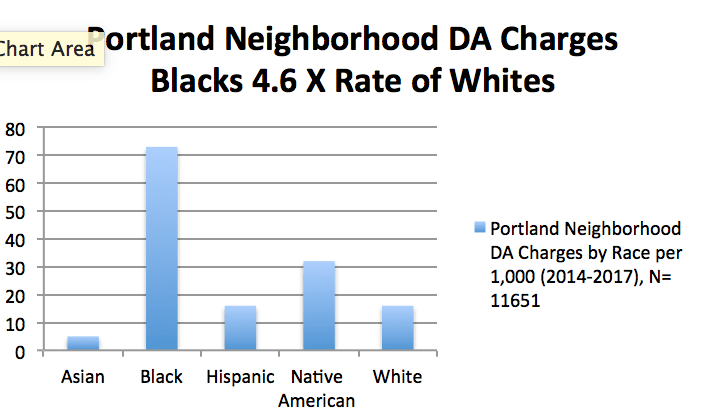
Last week the Portland Mercury published an article about attempts by Multnomah County, Oregon officials to censor data revealing stark racial disparities in Portland’s criminal justice system. Multnomah County research analyst Amanda Lamb used data from the courts, prosecutors’ offices and county jails to show that Blacks were 4.2 times more likely to be booked into jail than Whites. Once there, they stayed longer and were less likely to be released.
County officials challenged the data, insisting that the small numbers of cases in her study made any findings statistically insignificant. They promptly scrubbed the presentation from the Internet. Multnomah County District Attorney Rod Underhill complained, that Lamb “was not authorized to use that data . . . for public consumption.”
It’s strange that the District Attorney and county officials would try to hide this particular report. Numerous other studies have reached the same conclusion regarding racially disproportionate policing, arrest and incarceration rates in Portland. These include reports released by the Portland Police Bureau, the MacArthur Foundation, the Portland Tribune, Street Roots, and my own analysis of the DA’s data. All reveal that Black Portlanders are stopped, arrested, charged and detained at up to 6 times the rate of Whites in this progressive city run by left-leaning Democrats. Yet, in the face of all of this evidence, some going back several years, little has changed.
Charges
In a study I conducted of 11,651 cases brought between August 2014 and September 2017 by Portland’s Neighborhood District Attorneys, I found that Blacks were charged at 5 times the rate of Whites. The Neighborhood DAs are responsible for charging most of the quality-of-life crimes in the city, including such offenses as “offensive littering,” disorderly conduct, public urination, and prostitution.
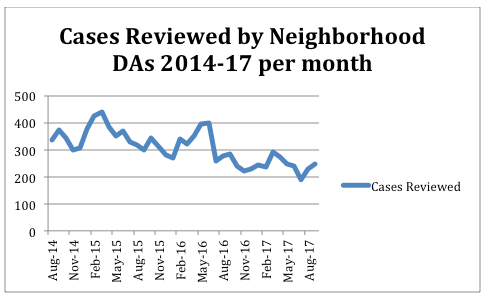
Although politicians and representatives for the Portland Police Department publicly renounce broken windows policing, the large numbers of charges and arrests for low-level offenses indicate many still practice it. On average, Neighborhood DA’s have reviewed over 300 cases per month in the last three years. While that average did decline last year, close to 250 people continue to be channeled into the criminal justice system for these low-level offenses each month in a city with a population of around 600,000 adults.
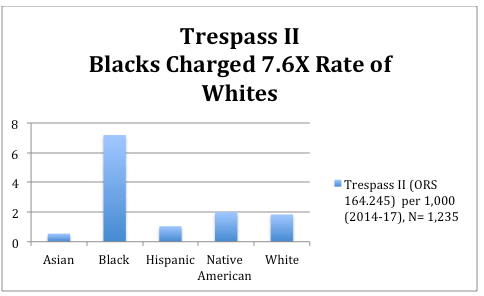
When we drill down to specific offenses, the racial disproportionality becomes even more pronounced. For example, Blacks were 8 times as likely as Whites to be charged with Trespass II (ORS 164.255), a class C misdemeanor used to charge those found to be unlawfully in a car or on property.
Blacks are six times as likely, and Native Americans more than twice as likely, as Whites to be charged with Interfering with a Police/Probation or Parole officer (ORS 162.247)
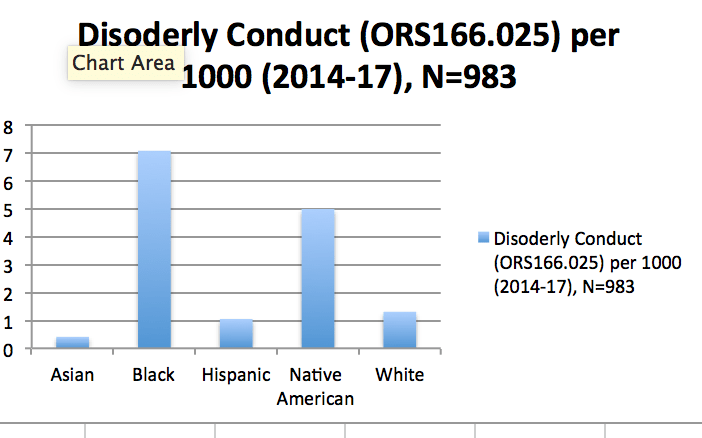
Police are granted broad discretion over whether and when to charge someone with disorderly conduct. (ORS 166.025)According to the statute, disorderly conduct may mean engaging in a fight, making “unreasonable noise” or obstructing pedestrian or vehicular traffic. Blacks face disorderly conduct charges at five times the rate, and Native Americans at four times the rate, of Whites.
Racial disparities are found in even the most low-level offenses, particularly in the category of “offensive littering.” Anyone who “creates an objectionable stench or degrades the beauty or appearance of property or detracts from the natural cleanliness” can be charged with this class C misdemeanor. Blacks are charged with “offensive littering” (ORS 164.805) at four times the rate of Whites.
Traffic Stops
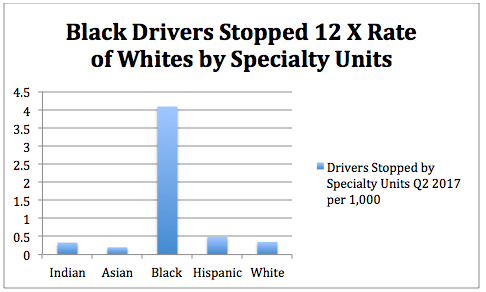
Traffic stops represent another area where over-policing leads to over-representation of Blacks in the criminal legal system. A 2002 Report by the Portland Police Bureau found that Blacks were disproportionately stopped by police, mostly under the pretext of vehicle violations. In 2014, another PPB Report, based on 2011 data, found that little had changed during the intervening 12 years, and that Blacks continued to be stopped at disproportionate rates. The latest stops data from the second quarter of 2017shows that no progress has been made in reducing the racial disparity in traffic stops. In fact, in some instances the disparity appears to have grown. The most egregious example of discriminatory stops is perpetrated by the Police Department’s Gang Enforcement Team, , which stops Black people at 12 times the rate of White people.
Portland has made progress in cutting the total number of stops in half from 114,000 in 2001 to around 50,000 in 2015. However, the impact of these stops still continues to fall disproportionately on Black people in the city.
Jail
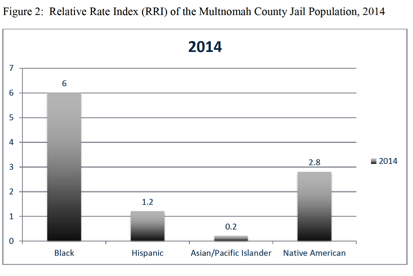
The MacArthur Foundation Safety and Justice Report released last year showed that racial disparities that begin with police stops are echoed in the disproportionate numbers of Blacks incarcerated in Multnomah County’s jail. Its study found that Blacks were six times more likely to be in jail on any given day than Whites in Portland.
Broken Windows Policing in an Era of Low Violent Crime
This data illuminates the extreme racial disparities that exist among those who are arrested each year in Portland for low-level offenses. Black Portlanders are targeted for these arrests at six to nine times the rate of Whites. The racial disproportionality can be found throughout the system, beginning with traffic stops, moving to arrests, to charges, and finally, to presence in the Multnomah County jail.
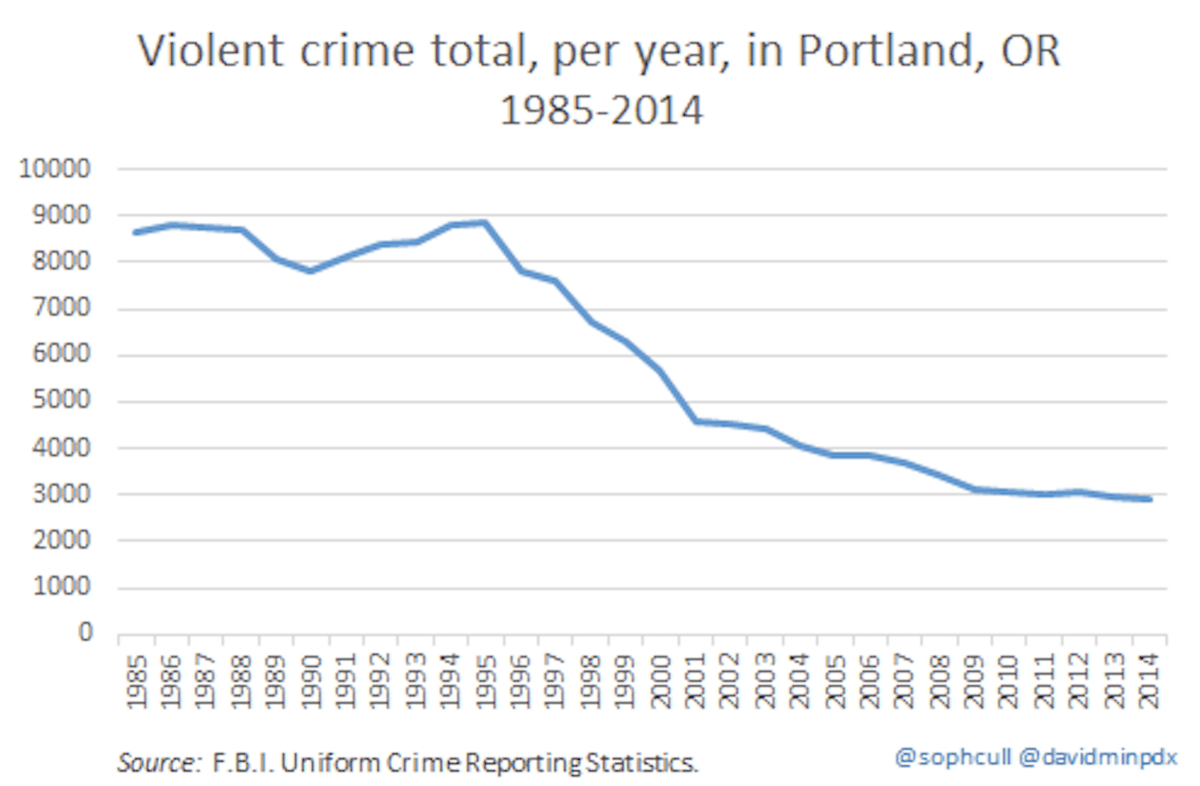
Given this data, one key question to ask Portland officials is why they are considering adding 85 new police officers even as violent crime in the city is at a thirty-year low? Recently, Columbia sportswear CEO Tim Boyle called for more policing in downtown because his employees faced harassment from people living on the street and some had laptops stolen from their cars. While such livability issues are real, one must balance the comfort of Boyle’s employees against the harm caused by over-policing of houseless people in downtown, including arrest records, fines, and jail-time. How many houseless people do we have to arrest to make Columbia sportswear employees feel safe?
If Portland hopes to reckon with its legacy of “systemic racism”, as Mayor Ted Wheeler has suggested, then it must do a better job of acknowledging the discriminatory policing rampant throughout the system. The Chief of Police and the Mayor should end broken windows policing and put into place policies designed to stop the over-criminalization of Black and Native American Portlanders, particularly for low-level, “quality of life” offenses.
